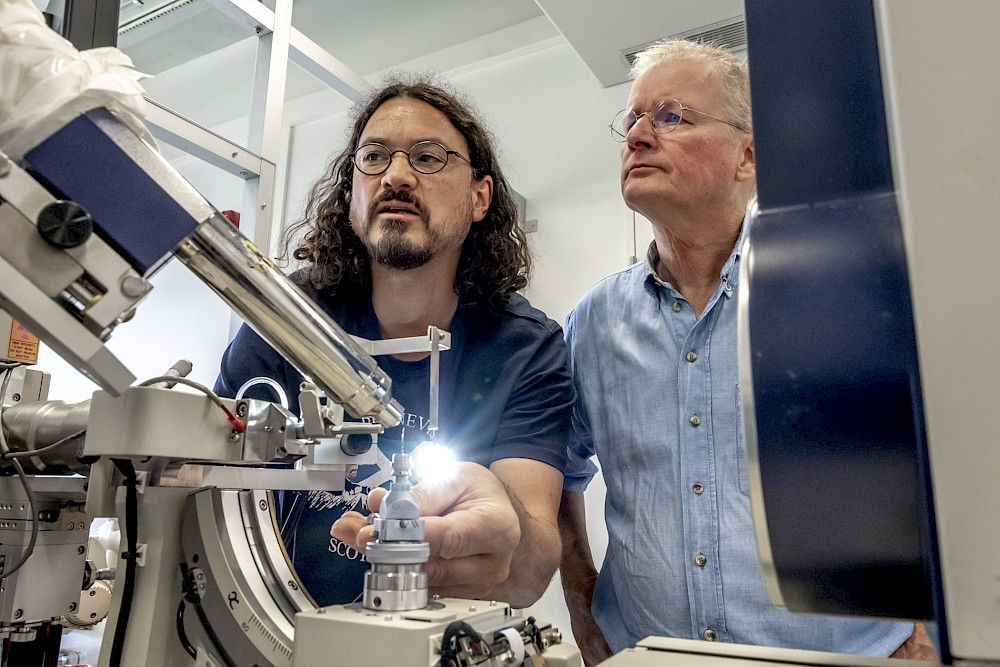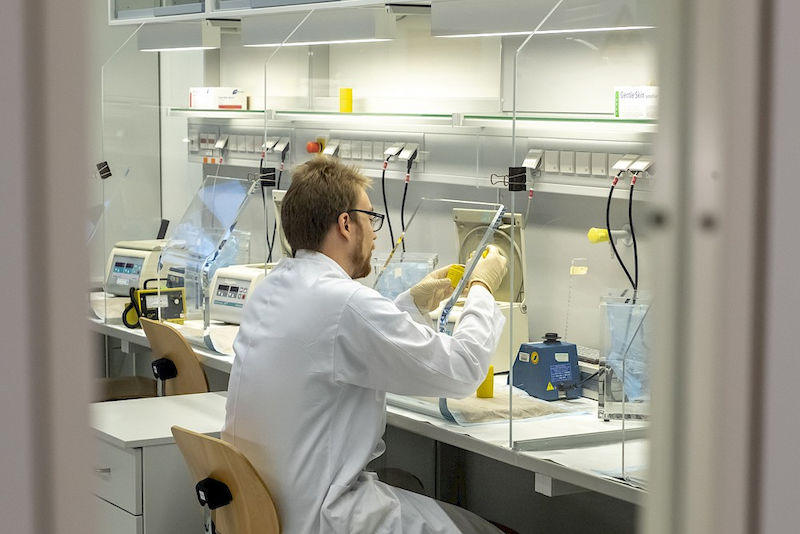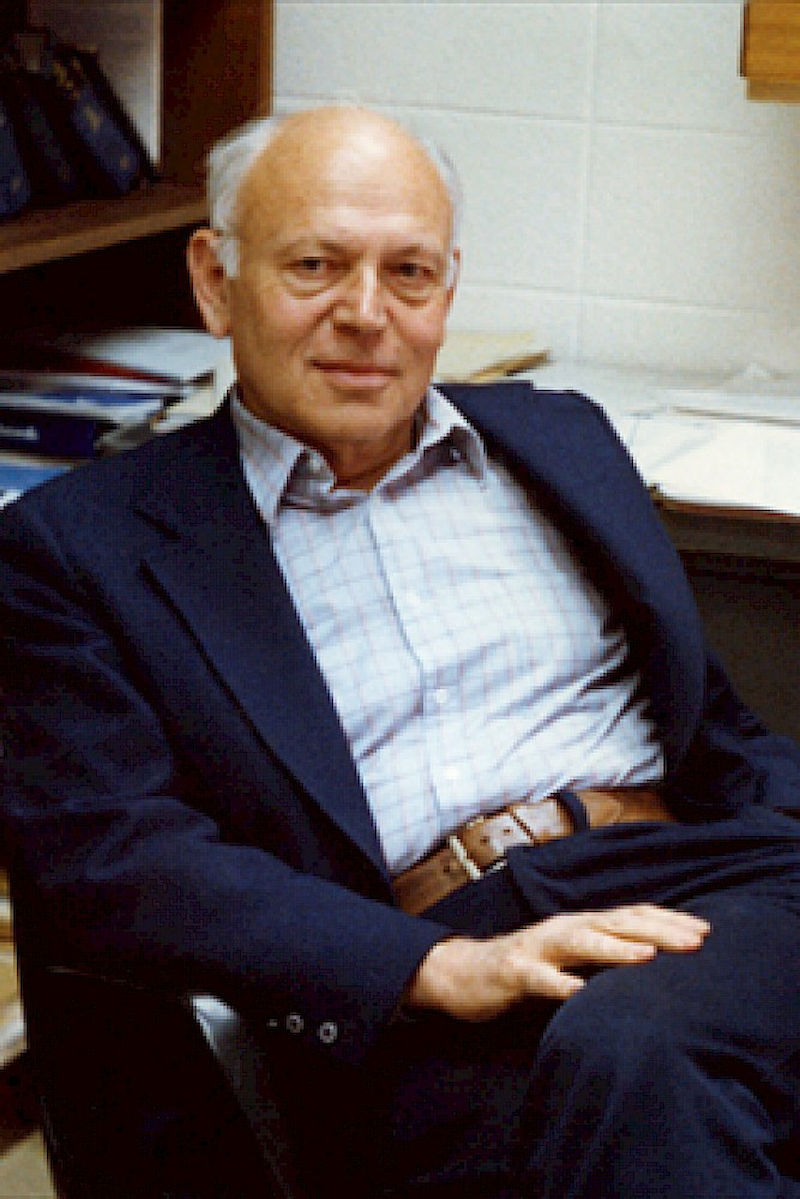Everyone under one roof

Professor Elmar Wahle and Professor Milton Stubbs have just spent a number of strenuous months. The two protein researchers lead two of the 14 research groups that have recently moved into the new Charles Tanford Protein Centre on the Weinberg Campus.
Previously the researchers were spread across five different locations in Halle. Not every moving box has been unpacked and every cabinet completely filled. But scientific life is already running again at full speed: In the laboratories, cell cultures are being prepared, samples are being taken and evaluated and protein structures are being investigated using X-ray equipment and mass spectrometers.
The Protein Centre has a floor space of around 5,400 square metres, spread out over four floors - space for 255 employees in 125 laboratories and 62 offices. All of the building’s technical systems – ventilation, extraction and filter units, as well as many other devices – are located on the roof of the Protein Centre, hidden behind sound barriers.
The building is in the shape of a cuboid, with the long sides offset from one another. The laboratories are located on the outer sides and the offices on the inner sides. The two building complexes are connected by several interconnecting corridors and a central staircase. This keeps distances between the office desk and the lab bench as short as possible. “My laboratories used to be spread across several floors. Now everything is close at hand and I am able to quickly exchange information with my colleagues,” says a satisfied Milton Stubbs. The professor of physical biotechnology is the Protein Centre’s spokesperson who acts as a link between the research groups, the university and the outside world.
Nine years of planning and construction
The idea to bring the university’s protein biochemistry research groups under one roof has a long history. It all started back in 2009 when Elmar Wahle was dean of the Faculty of Natural Sciences I. “The rectorate at the time - Chancellor Martin Hecht and Rector Wulf Diepenbrock - drew my attention to a call for proposals from the German Science Council for the funding of research buildings,” recalls the biochemist. He and his colleagues developed a draft proposal for a protein research centre in Halle. The idea was to cluster together a majority of the research groups working on protein biochemistry, i.e. groups from the Faculties of Natural Sciences I and II and from the Faculty of Medicine.
The concept: Research would be accelerated by the spatial proximity of the working groups and state-of-the-art infrastructure located in a common building. The spectrum was also to be expanded to include medical applications. It would be an ambitious project but came as no surprise. After all, protein biochemistry is part of Martin Luther University’s core research area “Biosciences - Macromolecular Structures and Biological Information Processing” funded by the state of Saxony-Anhalt. At the time the proposal was submitted, Halle’s protein researchers were already involved in major, externally funded projects, including a collaborative research centre and a graduate college of the Deutsche Forschungsgemeinschaft (DFG, German Research Foundation). The Federal Ministry of Education and Research was funding the competence network "ProNet-T3" in Halle and still funds the Centre for Innovation Competence (ZIK) HALOmem. In addition, numerous studies have been published in internationally renowned scientific journals.
The idea of a modern, cross-faculty centre for protein research in Halle ultimately also convinced the experts: in 2010, both the German Science Council and the Joint Science Conference favoured the construction of a research building for Halle’s new Protein Centre. The expert report states in particular that the practical orientation it aimed to achieve “also represents a unique selling point from a national standpoint”. The federal government and the state of Saxony-Anhalt would share the costs for the new research building, which would amount to around 40 million euros.
What came next was a period of intensive planning. “This phase took considerably longer than the actual application process,” recounts Elmar Wahle. Each working group that would be housed in the Protein Centre had to carry out extensive planning: Which laboratories are required? Where should equipment, such as mass spectrometers, NMR spectrometers, X-ray equipment and microscopes be located? Each room had to be planned in detail. ‘Floor representatives’ gathered together information about the requirements of the individual working groups and presented them at construction meetings. “I am deeply grateful to my colleague Dr Uwe Kühn, who spent a considerable part of his time at construction meetings and planning laboratories,” says Wahle. Frank Sauerländer from the Construction, Real Estate and Facility Management department headed the project on behalf of the university. Construction work began at the end of 2014 and lasted about three years.
Even the federal minister of education and research at the time, Professor Johanna Wanka, visited the centre in August 2017 when construction work had been completed. She praised protein biochemistry at the university, calling it “highly integrated, cutting-edge research”.
In honour of Charles Tanford
The Protein Centre is named after the scientist Charles Tanford (1921 - 2009) who was a pioneer in protein research. Born Karl Tannenbaum in Halle, his Jewish family emigrated to England in 1929 where they changed their family name. Charles Tanford received his academic education in the USA and spent his entire scientific life there. His work focused on the stability of protein structures.
Reliant on exchange
The research building is a place of interdisciplinary cooperation. The scientists not only contribute their specialist knowledge about the properties of certain proteins, they are also experts in special research methods. Elmar Wahle is well aware that this knowledge about methodology will become increasingly important in the future. “Scientific journals are increasingly demanding that new studies consist of a combination of different methods. That’s why we depend on the exchange of knowledge.” He now almost only publishes studies that have been developed in cooperation with other research groups.
The idea of joint cooperation is also reflected in the Protein Centre’s two ‘core facilities’ which are service facilities. ‘Imaging’ is a core facility that offers a variety of imaging technologies for analysing samples. These include high-resolution laser microscopy and infrared scanners. In the core facility ‘proteomic mass spectrometry’, which is currently still under development, researchers can use mass spectrometers to investigate proteins and their structures. The idea behind it is that not every research group needs to operate its own equipment. Instead, some devices can be used jointly. This saves money, space and valuable time, because not everyone has to learn everything from scratch.
The Protein Centre has raised the level of Halle’s protein research. It is clear that this should bear fruit, for example new third-party funded projects and publications in high-ranking journals. However, Stubbs and Wahle are taking a laid-back approach and do not want to raise expectations too much too quickly. Currently, Milton Stubbs regards his role as a spokesperson more in providing opportunities for professional exchange, for example through an open series of seminars. Research and cooperation take time and the work of the research groups in the new Protein Centre has only just begun.
Protein research in Halle
Research at the Protein Centre focuses on four major areas:
Membrane proteins: These special proteins are responsible for controlling and regulating important functions in the human body, such as the body’s immune response. Membrane proteins are therefore also of great interest for the medical and pharmaceutical industries. About half of all drugs currently in use target membrane proteins.
Proteins in post-transcriptional gene regulation: Protein biosynthesis in cells is divided into two major processes: transcription and translation. During transcription, gene segments are read by an enzyme and the information encoded in the DNA is transferred to an RNA molecule. During translation, proteins form according to the information contained in the RNA. Post-transcriptional gene regulation means that the use of RNA can be regulated. This plays an important role in developmental processes, for example.
Cancer: Scientists are investigating the role of misregulated proteins in the development of tumour diseases. At the same time, they are looking for special proteins that only occur in tumours, which can be used to develop new drugs.
Protein modifications: The structure of a protein determines its function. At the Protein Centre, work is carried out that examines how a protein’s structure is modified after synthesis and how this affects the way it functions.
Professor Milton Stubbs
Institute for Biochemistry and Biotechnology
phone: +49 345 55-24901
email: milton.stubbs@biochemtech.uni-halle.de


